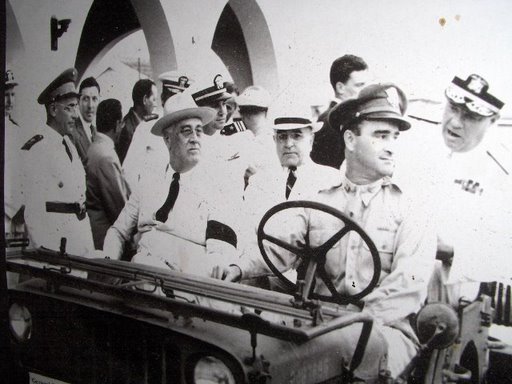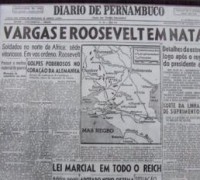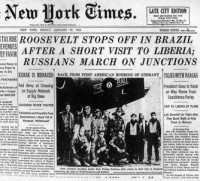ROOSEVELT/VARGAS SUMMIT AT NATAL 1943 - NATAL SUMMIT
2)THE FLIGHT
Natal. Morning of 28/Jan/1943. A huge camouflaged Flying Boat with US Navy livery landed smoothly on the waters of Potengi River. It was 07:50 AM. The giant plane with a wingspan of 152 feet, and length of 106 feet had two levels, three rudders and four engines.
The citizens of Natal already living closer to the World War had been accustomed to the roaring of the military airplanes landing and taking off at the river. However that aircraft was somewhat different in its call sign, not a Squadron logo or a Navy insignia but the letters NC 18605 at the tail, Pan American Airways on the fuselage and two large US flags on the nose and mid rudder.

Upon the arrival it followed some unusual proceedings, one boat came for picking the passengers that departed hastily to USS Humboldt, moored at one pier nearby, instead of the recently open Panair do Brasil Passenger station, a newly building with 8 arch architecture, one mooring pier for the Flying Boats and an observation tower at the third storey. That passenger building is now the famous “Prédio da Rampa” (The Ramp Building). 25 minutes elapsed when another Flying Boat with the same colors but with a different tail number NC 18604 lands having one feathered engine. Now things seemed to raise funded suspicions that something uncommon was going on.

These airplanes were two Boeing B-314 Clippers from Pan American Airways requisitioned by the US navy to perform the SM 71, Special Mission 71, with the main purpose to transport Pres. Franklin Delano Roosevelt from the Casablanca Conference for a summit with Brazilian Pres. Getulio Vargas, at Natal before leaving to Miami, from where the entourage would proceed by train to Washington. Mission SM 71 began at Bathurst, British Gâmbia. The planes had Pan American crewmembers in uniforms of US Navy Reserve, the NC 18604 christened as Atlantic Clipper was piloted by Richard Vidal and NC 18605, the Dixie Clipper was piloted by Howard M. Cone Jr and had as his co pilot Frank J. Crawford.
Each plane carried 10 crewmembers. The “Dixie” carried the Pres. Roosevelt and 8 aides. That same plane had made history earlier when in 1939 opened Pan American US-Europe scheduled flights. The VIP passengers enjoyed at first a turbulent flight, until the pilots had been forced to descent to a lower altitude, barely 1000ft, for the rest of the route, comprising 1841 miles (2.962 Km) as far as Natal.
When Brazilian coastline came into sight, an oil leakage was noticed on aircraft NC 18604 in the #3 Engine and in view of the situation the Flight Engineer Donald R. Fowler recommended the pilot to cut off the engine and have the propeller feathered. Having departed Bathurst at 11h36PM local time on 27 Feb 1943, the aircraft gained 3 hours at the Atlantic crossing due to very favorable tailwinds.
NC18604 which departed earlier arrived at Natal 25 minutes later due to the feathered engine and landed after NC 18605. But some more developments were on the way. After all, where Brazilian President Vargas was? The same would have a summit with President Roosevelt at Natal.
In absolute secrecy he had already landed in the first hours of 28th, in one flight which departed Rio de Janeiro with American military authorities among them Adm. Ingram, Commander of the Fourth Fleet, and the US Ambassador Jefferson Caffery. Late in the morning of 28th President Vargas staff announced his presence when he was aboard USS Jouett. The news stirred the city.
Pres. Roosevelt is seen in the “Jeep 7” and in the back seat are seen Brazilian Pres. Vargas sided by Adm. Jonas Ingram. Both presidents made a tour at Parnamirim Field and other military facilities, including the seaplane “Ramp”. Vargas and Roosevelt spent the whole day of 28th together, having visited first the VP-74 Squadron which was based at the former German part of the Ramp, the base of Condor Syndikat the German Airline in Brazil until 1939, sided by the facilities of Panair do Brasil.
From there, the motorcade went in inspection of Brazilian and American military establishments culminating with the visit at Parnamirim Field, and ATC Headquarters Air Transport Command South Atlantic Wing including the VP-83 Squadron, that a few days earlier had sunk the first U-boat in Brazilian waters, U-164.
They made their way back to the Ramp this time in one black sedan through the Pedro Velho Square when both were seen by the Brazilian author Lenine Pinto, who wrote several books focusing this period. With the unexpected malfunction in one Atlantic Clipper, the U.S Navy orders another one to replace, the American Clipper, but Roosevelt could not wait. In the first lights of the morning of 29/Feb/43, the presidential entourage departs at 05:10AM to Parnamirim Field, where two Douglas C-54 wait for them for a long flight to Trinidad, where two Clippers would make the final leg to Miami.
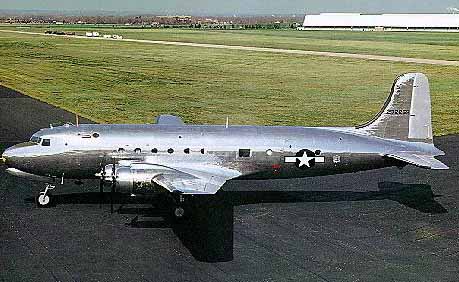
The ATC C-54 had already served President Roosevelt during his trip to the Casablanca Conference and both were sent to Natal to remain in standby. The planes had a TWA aircrew, pilots Otis Brian and Don Terry. (then Trans Western Air, later the Howard Hughes Trans World Airlines. Brian’s C-54 departed with President Roosevelt at 06:00AM, soon followed by the second plane 15 minutes later, having established a cruise altitude of 8 to 10 thousand feet and a cruising speed of 180 mph (290 Km/h).
Roosevelt landed at Waller Field Trinidad at 04h15PM, local time covering 2135 miles (3435 Km) in 11:15 min. On Jan the 30th the President and his staff drives to the Cocorite airdrome to board the Dixie and American Clippers. Captain Cone of the Dixie Clipper departs at 07:00AM, and at 12h30PM (04:30PM GMT) they drank a toast to celebrate the 61 years birthday of Roosevelt, with the Dixie Clipper flying over a shimmering Caribbean Sea.

For that special occasion the crew prepared a selected menu with caviar and toasts, celery sticks, olives, broiled turkey with cranberry sauce, green peas, baked potatoes and coffee. Once the President finished the lunch and the dishes were removed, a truly birthday cake with candles was presented to the him, who sliced and duly partitioned with his staff at 8,000 feet altitude. In the picture below Adm. Leahy in the left, Harry Hopkins in bottom right and Capt. Howard Cone the plane's pilot.

Birthday Dinner for President Roosevel aboard Clipper enroute from Trinidad B.W.I. to Miami Jan 30 1943 after Casablanca Conference. Back Row. Capt. John Mc Crea, Naval Aide to President Elmer Hipslay, Secret Service Agent Lt. Fox, Admiral Ross T. Mc interest Lt. Cone. Front Row: Guy Spaman, Secret Service Agent, Admiral W.D. Leahy, President Roosevelt celebrating his 61st Birthday. Photo LIFE Magazine.
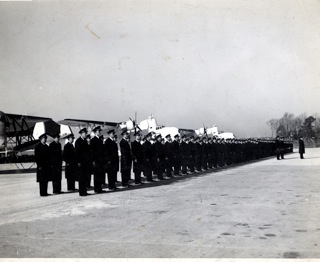
Officers lined up at Parnamirim Field for inspection by Roosevelt and Vargas in January 1943. Picture kindly sent by William DeArmond.
At 04:35PM on Jan the 30th 1943, both Clippers landed smoothly at Miami from where they departed on January the 11th at SM 70 for that long historical journey to North Africa and Brazil whose first destination was Bathurst (British Gâmbia) via Port of Spain, Trinidad and Belém, Brazil. Mission accomplished.
By Fred Nicolau at www.fundacaorampa.com.br
